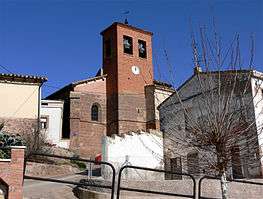Torrecilla sobre Alesanco
_-_Municipality_Map.svg.png)
Torrecilla sobre Alesanco is a village in the province and autonomous community of La Rioja, Spain. The municipality covers an area of 4.36 square kilometres (1.68 sq mi) and as of 2011 had a population of 38 people.[1]
Geography
Position
It has a privileged situation for having a 617 metres oficial average altitude, between Nájera and Santo Domingo de la Calzada. Actually, it is 12 km far from each other. Nearby there are different villages, such as San Millán de la Cogolla (15 km), Cañas (2 km) and Logroño, the capital city of La Rioja (37 km).
It is placed in the medium course of the Tuerto river.
History
The first documentary mention of the village appears in the regional code of laws of Nájera, admitted by Sancho III of Pamplona around the year 1020 and verified by Alfonso VI of León and Castile in 1076.
In the 12th century, Mrs. Toda Petriz, who was Mr. Pedro López de Haro’s widow, quoted Torrecilla in a donation writing.
In 1215, Mrs. Toda relinquised the locality to Santa María la Real of Nájera monastery, in assistance for her soul.
Landmarks

The parochial church of Asunción was built in the 16th and 17th centuries. It is an ashlar work with recent added bricks.It consists of a nave with an arched form used to provide a space with a ceiling or roof and two side chapels. Lately, the upper part of the tower has been reconstructed with bricks.
The chancel, the space around the altar, includir the choir and the sanctuary, is an altarpiece with:
- Pew:In the sanctum pew, a prie-dieu image of Saint Isidore of Seville and the sculpture of Our Lady of the Pillar are placed.
- Attic: In the attic, a sculpture of Jesus Christ in the cross can be seen.
- Three aisles
In the two side chappels, there are two sculptures one of Assumption of Mary and the other of the Descent from the Cross
In the nave, two altarpieces more are shown: the first one in honour of Valvanera Virgin, while the second one was dedicated to the Immaculate Conception.
Landscape
According to the landscape tipology, the wood has been repoblated with pine trees, although it still preserves some oaks. Among the wide diversity, the most plentiful animals in this area are: the medium-size predatory animals, foxes, rabbits and partridge birds.
Economy
The economy in this village is mainly agricultural based on cultivations of potatoes, beetroots, wheat and barley. However, a quarter of the total worked area is destined to vineyards.
The cattle herd (including bovine and porcine) which Pascual Madoz described in his "Geographic, Statistical and historical dictionary of La Rioja" a century ago has been currently reduced to two pig farms.
Local festivities
- 15 August in honour of Our Assumption of the Virgin Mary into Heaven
- Thanks offering, 3rd Saturday with traditional dances
- Corpus Christi’s Eve, religious pilgrimage to the Valvanera monastery, commemorating the disappearance of a disease that devastated the village in 1523. Until recently, the romeria has been celebrated on 25 March. They move in carriages and pick up stones from the Sanctuary which when thrown to the air, protect their fields from storms.
- On 14 May, eve of Isidore the Farm Labourer, Isidore of Seville is celebrated. On 15 May both saints travers in procession through the fields.